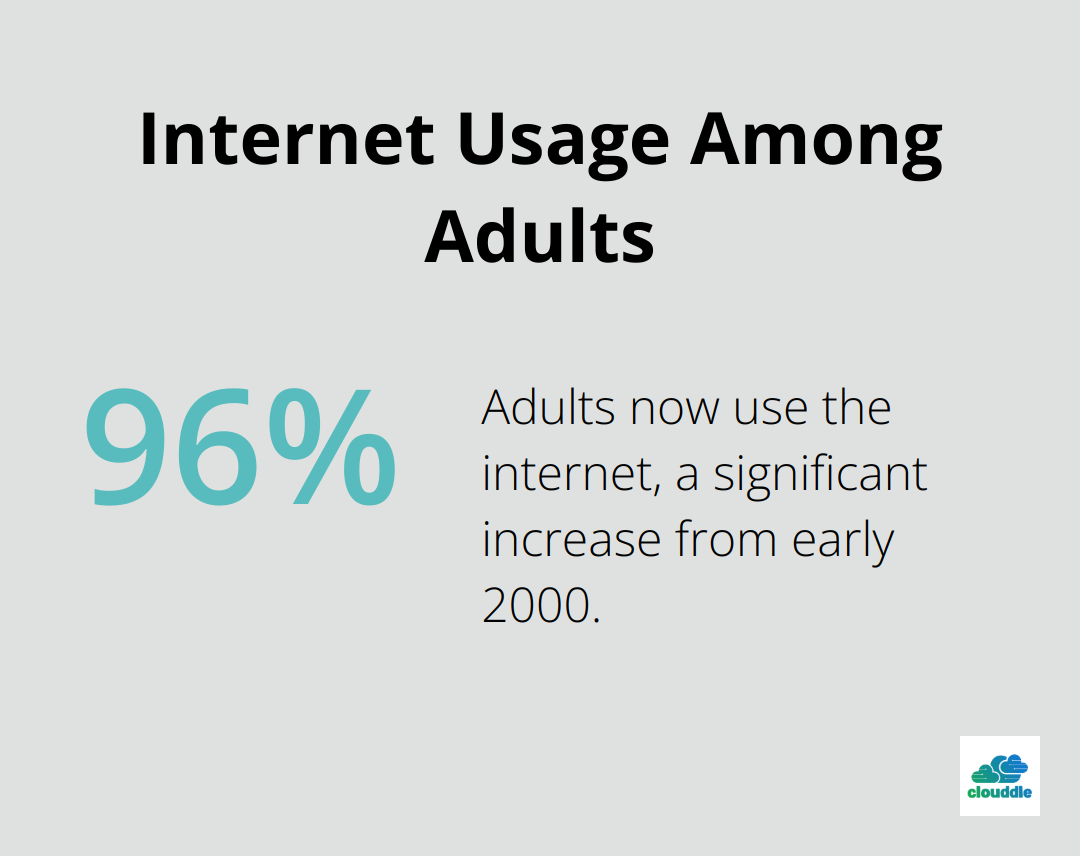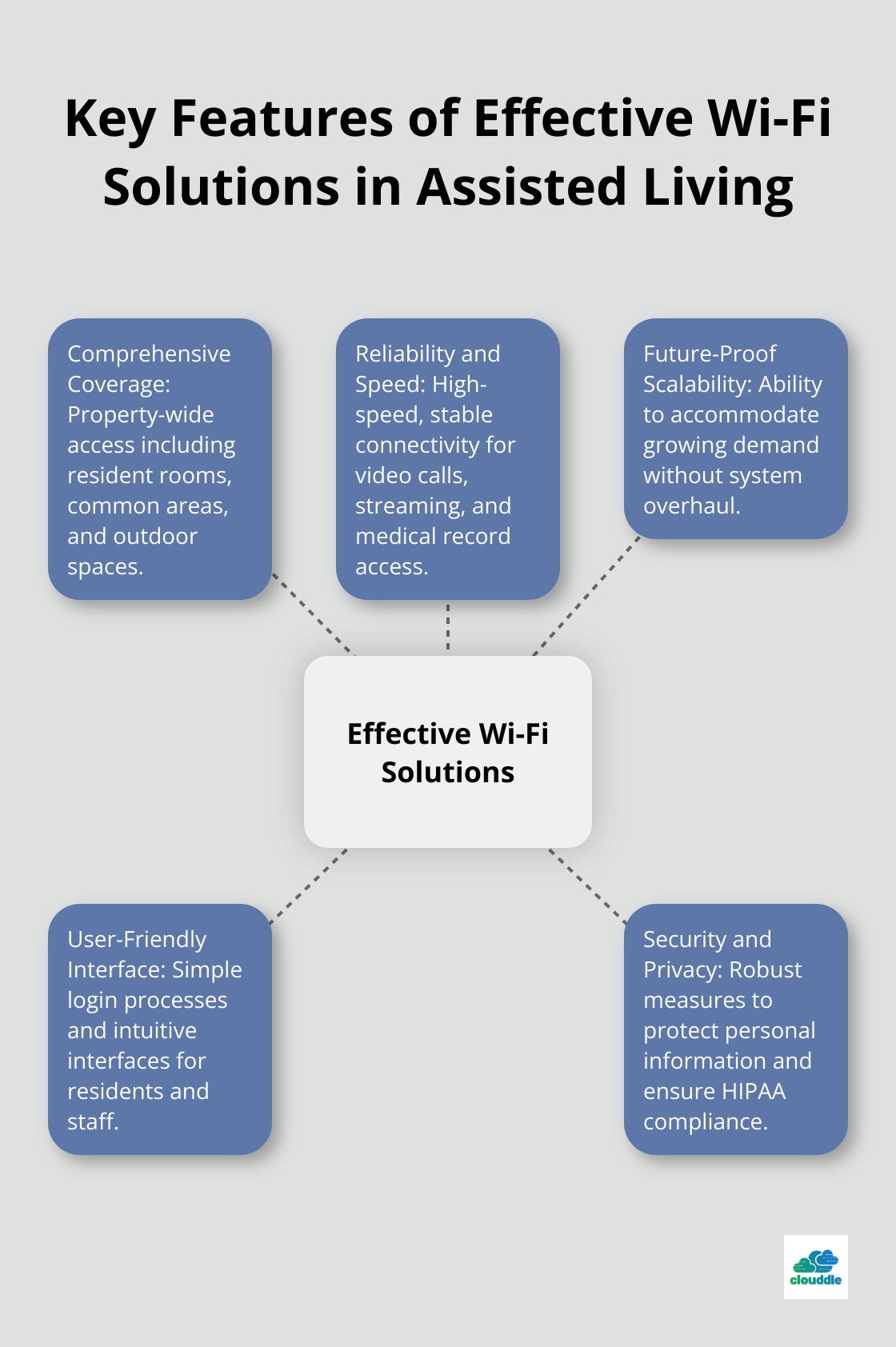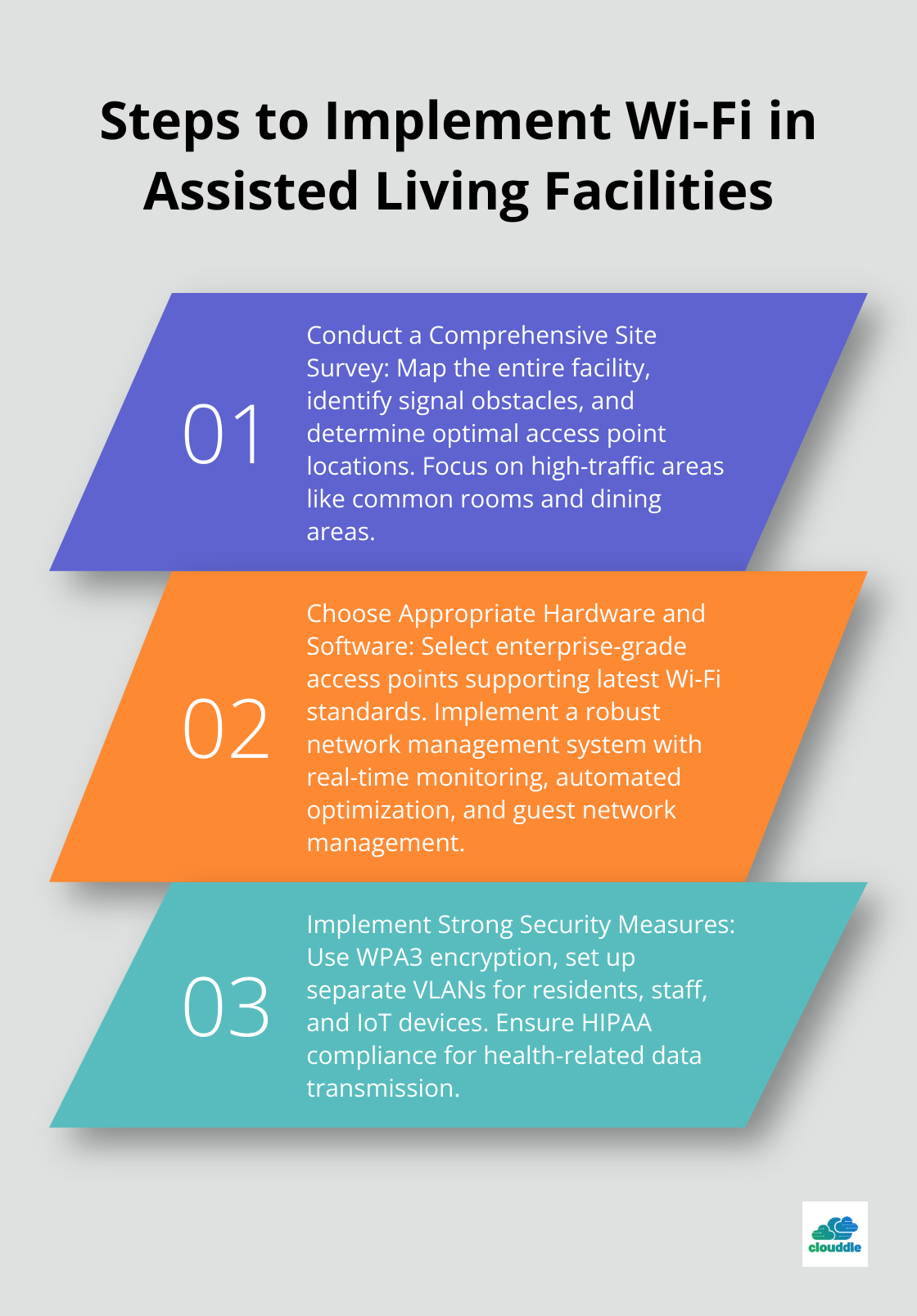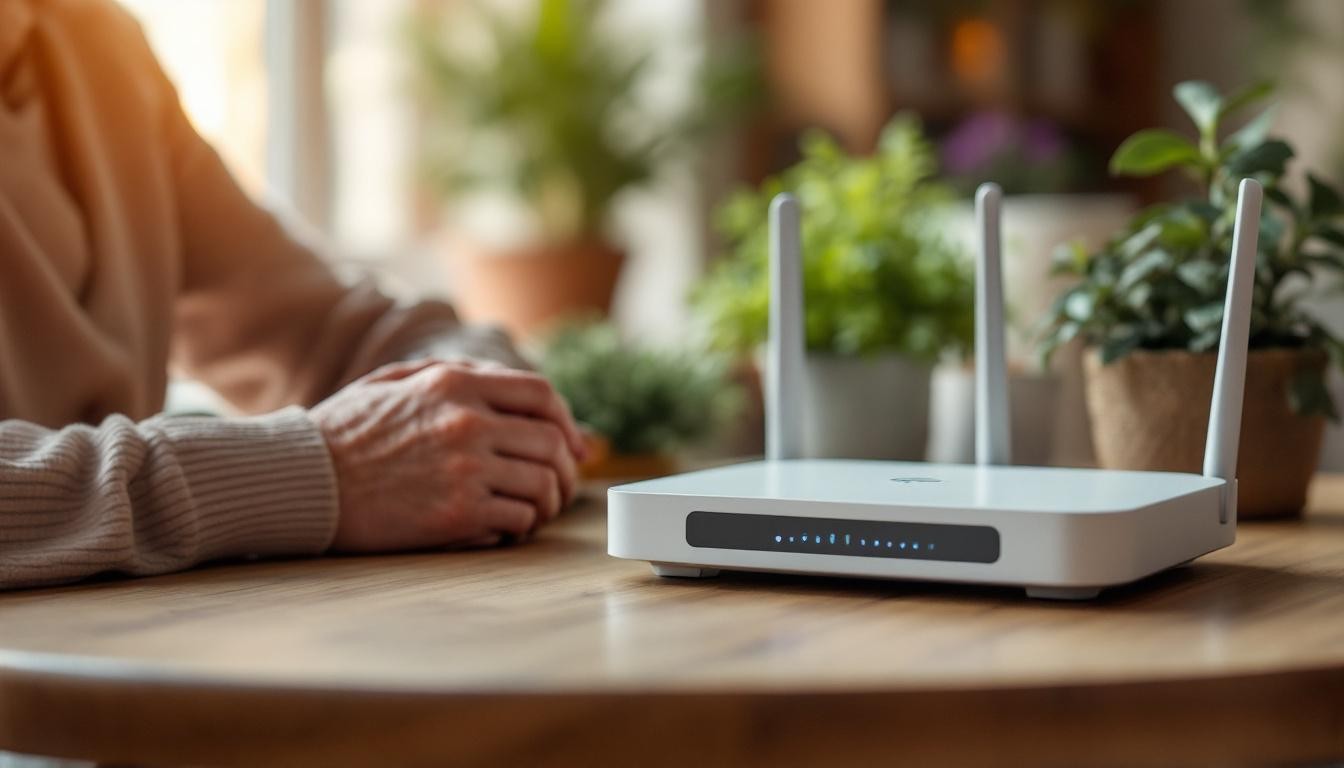Wi-Fi solutions for assisted living facilities have become essential in modern senior care. These technologies enhance residents’ quality of life, support healthcare services, and improve staff efficiency.
At Clouddle, we understand the unique challenges faced by assisted living facilities when it comes to implementing robust Wi-Fi systems. This blog post explores the key features and implementation strategies for effective Wi-Fi solutions in senior care environments.
Why Wi-Fi Matters in Assisted Living
Transforming Senior Care with Connectivity
Wi-Fi has become a game-changer in assisted living facilities. It’s not just about providing internet access; it transforms the lives of residents and improves operational efficiency.
Closing the Digital Gap for Older Adults
Pew Research reports that 96% of adults now use the internet, up from about half in early 2000. This significant increase demonstrates that older adults embrace technology more than ever. Wi-Fi in assisted living facilities helps close the digital gap, allowing residents to stay connected and engaged with the world around them.

Strengthening Family Bonds
Wi-Fi enables residents to maintain close ties with their loved ones. Video calls, social media, and instant messaging apps have become essential tools for family communication. A study published in the Journal of the American Medical Directors Association (JAMDA) found that comprehensive, property-wide Wi-Fi access increased satisfaction among residents.
Revolutionizing Healthcare Delivery
Telehealth services have gained importance, especially in light of recent global health challenges. Wi-Fi supports these services, allowing residents to consult with healthcare providers remotely. The National Institutes of Health reports that older adults who use Wi-Fi-enabled monitoring platforms experience improved health outcomes and reduced hospitalization rates.
Empowering Staff and Enhancing Care
Wi-Fi benefits not only residents but also serves as a powerful tool for staff. It enables real-time access to patient records, facilitates quicker response times, and supports the use of IoT devices for monitoring and care. For example, Atria Senior Living observed significant improvements in staff response times after implementing a robust Wi-Fi network.
As we move forward, the role of Wi-Fi in enhancing the quality of life for seniors will only continue to grow. The next section will explore the key features that make Wi-Fi solutions effective in assisted living environments.
What Makes Wi-Fi Solutions Effective in Assisted Living?

Comprehensive Coverage
Effective Wi-Fi solutions in assisted living facilities must provide comprehensive coverage throughout the entire property. This includes resident rooms, common areas, outdoor spaces, and staff areas. For multiple dwelling units, assisted living WiFi is crucial for residents and guests.
Reliability and Speed
High-speed, reliable connectivity is essential in assisted living facilities. Residents depend on stable connections for video calls with family and streaming entertainment. Staff members require dependable Wi-Fi for accessing medical records and using IoT devices for resident care. If you’re a large system, which can mean hundreds of employees, the Federal Communications Commission (FCC) recommends a minimum 1000 Mbps.
Future-Proof Scalability
The demand for Wi-Fi in assisted living facilities continues to grow rapidly. Industry experts predict that the number of connected devices in senior living communities will triple by 2025. Effective Wi-Fi solutions must scale to accommodate this growth without requiring a complete system overhaul.
User-Friendly Interface
Both residents and staff should find the Wi-Fi system easy to use. This means simple login processes, clear instructions, and intuitive interfaces for any associated apps or portals. User-friendly Wi-Fi solutions can significantly reduce dependency and increase adoption rates.
Security and Privacy
In assisted living environments, security and privacy are paramount. Effective Wi-Fi solutions must incorporate robust security measures to protect residents’ personal information and ensure compliance with healthcare regulations (such as HIPAA). This includes features like encrypted connections, secure guest access, and regular security updates.
To meet the unique needs of assisted living facilities, Wi-Fi solutions must combine all these features. The best providers (including Clouddle) focus on delivering comprehensive, reliable, scalable, and user-friendly Wi-Fi solutions tailored specifically for senior living environments. These solutions ensure that both residents and staff can fully benefit from the transformative power of connectivity in assisted living settings.
Now that we understand what makes Wi-Fi solutions effective, let’s explore how to implement these solutions in assisted living facilities.
How to Implement Wi-Fi in Assisted Living Facilities

Conduct a Comprehensive Site Survey
A thorough site survey forms the foundation of any successful Wi-Fi implementation. This step involves mapping the entire facility, identifying potential signal obstacles, and determining optimal access point locations.
This improvement is particularly important in assisted living facilities where building materials (like concrete and metal) can interfere with signals.
The survey should focus on areas where residents gather, such as common rooms and dining areas. These high-traffic zones often need additional access points to handle increased device density.
Choose Appropriate Hardware and Software
The selection of the right equipment is critical. For assisted living facilities, enterprise-grade access points that support the latest Wi-Fi standards (Wi-Fi 6 or Wi-Fi 6E) are recommended. These newer standards offer better performance in high-density environments and improved battery life for mobile devices.
A robust network management system is essential on the software side. Look for solutions that offer:
- Real-time monitoring and alerts
- Automated channel and power optimization
- Guest network management
- Bandwidth allocation controls
These features allow IT staff to manage the network proactively, ensuring consistent performance for all users.
Implement Strong Security Measures
In assisted living environments, security protects both data and people. Implement WPA3 encryption on all networks and use a next-generation firewall to guard against cyber threats.
Set up separate VLANs for residents, staff, and IoT devices. This segmentation adds an extra layer of security and allows for more granular control over network access.
For resident privacy, implement MAC address randomization to prevent device tracking. Ensure that any health-related data transmitted over the network complies with HIPAA regulations.
Provide Comprehensive Training
The best Wi-Fi system is only as effective as its users’ ability to leverage it. Develop a training program that caters to both staff and residents. For staff, focus on network management basics, troubleshooting common issues, and using Wi-Fi-enabled care devices.
Create easy-to-follow guides for residents on connecting devices, using Wi-Fi calling, and accessing online services. Offer regular tech support sessions where residents can get one-on-one assistance.
Elderly individuals face challenges in adopting and using digital health platforms. Negative attitudes and technology anxiety can prohibit initial adoption.
Establish a Maintenance and Upgrade Schedule
Wi-Fi technology evolves rapidly. What’s cutting-edge today may become outdated in a few years. Establish a regular maintenance schedule to keep the system running smoothly. This schedule should include:
- Monthly software updates and security patches
- Quarterly performance reviews and optimization
- Annual hardware inspections
Plan for major upgrades every 3-5 years to take advantage of new Wi-Fi standards and improved hardware capabilities. This proactive approach ensures that your facility always offers the best possible connectivity to residents and staff.
Final Thoughts
Wi-Fi solutions for assisted living facilities have become essential in modern senior care. These technologies enhance residents’ quality of life, support healthcare services, and improve staff efficiency. Effective Wi-Fi implementations require comprehensive coverage, reliability, scalability, user-friendliness, and robust security measures.
The benefits of Wi-Fi in assisted living extend far beyond basic internet access. It closes the digital gap for older adults, strengthens family bonds, and revolutionizes healthcare delivery. With the right implementation strategy, assisted living facilities can harness the full potential of Wi-Fi technology (including thorough site surveys and appropriate hardware selection).
Clouddle specializes in delivering tailored Wi-Fi solutions for assisted living facilities. Our Network as a Service approach combines networking, entertainment, and security, providing seamless operations without initial investment. We ensure that your facility stays connected and secure, allowing you to focus on providing excellent care for your residents.


